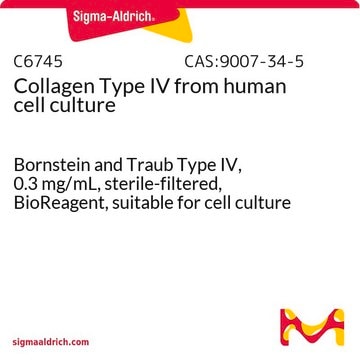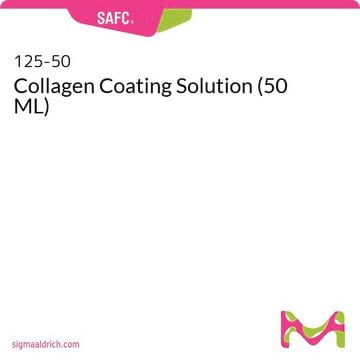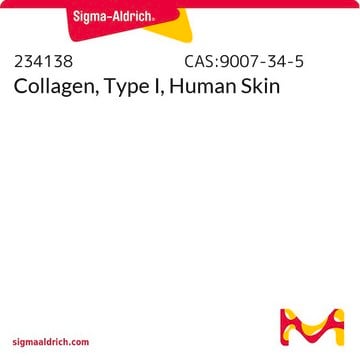As indicated above under 'PROPERTIES', this collagen solution is sterile-filtered.
추천 제품
제품명
Collagen Solution from human fibroblasts, 3 mg/mL, sterile-filtered, BioReagent, suitable for cell culture
생물학적 소스
human fibroblasts
Quality Level
무균
sterile-filtered
제품 라인
BioReagent
양식
solution
포장
pkg of 20 mL
농도
3 mg/mL
기술
cell culture | mammalian: suitable
표면 범위
6‑10 μg/cm2
결합 특이성
Peptide Source: Collagen
Peptide Source: Elastin
외래 활성
endotoxin ≤5.0 μmole/min-mg protein
배송 상태
wet ice
저장 온도
2-8°C
일반 설명
애플리케이션
생화학적/생리학적 작용
Storage Class Code
10 - Combustible liquids
WGK
nwg
Flash Point (°F)
Not applicable
Flash Point (°C)
Not applicable
이미 열람한 고객
문서
Extracellular matrix proteins such as laminin, collagen, and fibronectin can be used as cell attachment substrates in cell culture.
-
How did you steralize this collagen?
1 답변-
도움이 되었습니까?
-
-
Is this product suitable for 3D gel formation? How should it be neutralized? How quickly does it polymerize once neutralized? Is there a protocol available for 3D gel formation?
1 답변-
Procedure for 3-D Gel Preparation:
1. Mix 8 parts of chilled collagen solution with 1 part of
10 X PBS (Catalog Number P5493 or P5368) or
10 X culture medium. Cells may be added following
this step.2. Adjust pH of mixture prepared in step 1 to 7.2–7.6.
Use of 0.1 M NaOH (10-fold dilution of Catalog
Number S2770) or 0.01 M HCl (100-fold dilution of
Catalog Number H9892) is recommended. Monitor
pH adjustment carefully with pH meter, phenol red,
or pH paper.3. To prevent gelation, maintain temperature of the
mixture at 2–8C. To form gel, warm to 37C. For
best results allow 45 minutes to 1 hour for gel
formation.4. The gels can be dried under a laminar flow hood.
도움이 되었습니까?
-
-
Is the monomer a tropocollagen?
1 답변-
The human collagen is secreted from fibroblast cells, which cleave the loose ends of the procollagen molecule, leaving what is considered tropocollagen with the telopeptide region intact. An enzyme step is utilized to cleave the telopeptide, resulting in Atelocollagen, which maintains its triple helical formation but without the telopeptide region.
도움이 되었습니까?
-
-
What is the 2D Hydrogel protocol for Product No. C2249?
1 답변-
There has been no internal protocol for C2249 however this paper describes protocol for 2D Collagen Gel. Hong H, Stegemann JP. 2D and 3D collagen and fibrin biopolymers promote specific ECM and integrin gene expression by vascular smooth muscle cells. J Biomater Sci Polym Ed. 2008;19(10):1279-93. doi: 10.1163/156856208786052380. PMID: 18854122; PMCID: PMC2731795.
도움이 되었습니까?
-
-
Is this a monomer?
1 답변-
This product is a mix of monomers, dimers, trimers, and oligomers, with some remaining collagen fragments.
도움이 되었습니까?
-
-
What solvent is used for product C2249?
1 답변-
The solvent for product C2249 is 13 mM HCl.
도움이 되었습니까?
-
-
What is the acid, and concentration of acid, that the collagen is solubilized within?
1 답변-
The acid used to prepare this product is HCl. The final concentration of the solvent is 13 mM.
도움이 되었습니까?
-
활성 필터
자사의 과학자팀은 생명 과학, 재료 과학, 화학 합성, 크로마토그래피, 분석 및 기타 많은 영역을 포함한 모든 과학 분야에 경험이 있습니다..
고객지원팀으로 연락바랍니다.







